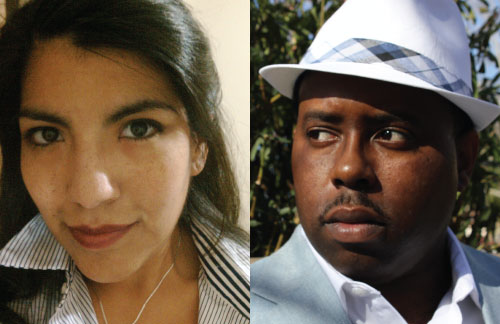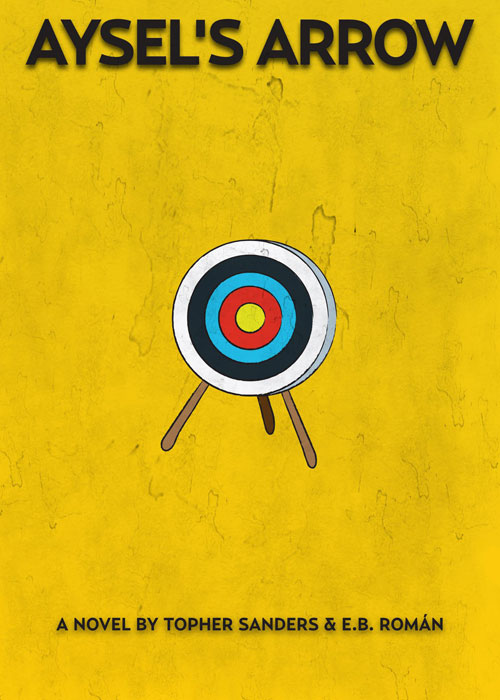My friend and former colleague Topher Sanders and his friend Elizabeth Román have written a book, “Aysel’s Arrow,” which is released today. The book is women’s literature, and focuses on a Latina whose new relationship forces her to deal with issues with her family and her past. Get it on Amazon here.
Topher asked me to design the book’s cover. To read more about that, go here.
Elizabeth’s work has been published in “Working with Student Writers: Essays on Tutoring and Teaching, Second Edition.” Additionally, she was a reporter with
the New York Times Company. She currently works and lives in Washington, D.C.
Topher is an award-winning reporter whose beat work has been recognized by editor associations in New York and Florida. His freelance work has appeared in Essence, Black Enterprise and Newsweek magazines and Washington Post Company subsidiary TheRoot.com. He is currently a reporter with The Florida Times-Union in Jacksonville, where I had the pleasure of working with him.
I asked Topher and Elizabeth some questions, which they graciously answered.
How did the idea of the book come about?
Topher: We were talking one day about both of us having aspirations to write a book. And we were looking at some of the books that were already on the shelf and saying to each other “we could do that.” With me being black and Elizabeth being Latina, we knew we wanted to write about people of color. But we also didn’t want to write about black and brown folks in the circumstances typically drawn out in books or movies — thugs, down and out, annoyingly successful or magical. Honestly we were just tired of the trite stereotypes, so we wanted a lead character that felt different to us, a protagonist with more texture. So we sought to write something that made us proud in that regard.
Elizabeth: We started by dumping all of the things we liked about people we knew, or had met, or could imagine into a creative pot. We are both big readers – so our next step was to narrow down ideas to ones that we longed to see expressed in popular fiction. Right away emerged a female protagonist who was a tough Latina with strong family ties. Then we built around her a world filled mainly with people of color. It was important that our characters were relate-able, universal, but also reflected an authentic cultural voice. The storyline itself emerged slowly as we tried on different scenarios. What I’m most proud of about this book was that it was an entirely creative process. We started many late-night conversations with, “What if” as we developed each moment and each character out of thin air. A heavy amount of research followed, of course, including trekking through Chicago neighborhoods and learning about archery.
What writers or novels inspire or at least inform the way you wrote the book?
Elizabeth: Michele Serros is my hero. She wrote “How to Be A Chicana Role Model” along with the “Honey Blonde Chicaseres.” She was the first Chicana writer I’d read that wasn’t afraid to be funny. It was also clear she wasn’t trying to be Sandra Cisneros or do the magic-realism thing of Laura Esquivel. Serros spoke to the first or second generation Chicanas who bleached their hair, listened to hip-hop, and ate chicharones during their community college classes. Her work inspired us to write this novel with the same fearlessness, eschewing stereotypical ideas about what a Latina or a black man in the U.S. likes to do, who they love, or how they end up.
Topher: In addition to Michele, for me it’s Junot Diaz. Mr. Diaz is that dude. I am in no way putting “Aysel’s Arrow” in the same ballpark as “The Brief Wondrous Life of Oscar Wao,” but it’s Diaz’s work that totally pushed me to continue developing, smoothing and carving out Aysel’s world, family and struggles. My wife absolutely got tired of me talking about Diaz. His characters are so “neighborhood,” and by that I meaning real and tangible — I know someone like Oscar and his sister and everybody knows Oscar’s mom. But those characters are crafted in a way that propels them out of their usual landscape and pushes the envelope on their experience. We want to be able to do that with our characters. So Aysel is the first of many attempts to extend the experience of characters of color.
How did the idea of co-writing come about, instead of having one writer?
Elizabeth: We were talking about our mutual aspiration to complete a novel and the frustration with being able to get started. Since at the time we were both professional journalists who were used to writing under a deadline, we thought that perhaps by joining forces we could accomplish our goal, together, in a shorter time frame.
What were the challenges of having two writers?
Elizabeth: Our schedules was the hardest part of this project. Most of our collaborations occurred during 5 a.m. phone calls before we had to be at work, or late in the evening after returning from long shifts. Even still, we found that our paying gigs, family, and other unforeseen life events, sometimes clashed directly with our best laid plans. There were months when we couldn’t get into sync. Fortunately, however, we never lost the faith at the same time. When one of us was on empty, the other was right there with a full can of gas.
What were the strengths of having two writers?
Topher: Being able to push each other. When one of us got discouraged or distracted, the other would be like “yo, you want to do this or not?” We’re really close, so that helped a lot. I’m not sure two people could do this if they weren’t close and candid with each other. We didn’t worry about offended each other when one person had to critique the other’s writing. Our willingness to hear each out and be flexible were key factors enabling us to finish the novel and get the best out of each other.
Elizabeth: We also both have high standards. Our honesty and directness were huge assets during this process because we didn’t let each other off the hook with the writing. If something was crap, told each other without taking it personally. And we kept revising and revising until we were both satisfied.
What inspired the anime festival where Aysel meets Courtney?
Elizabeth: We are both are sci-fi nerds (though Topher doesn’t admit to being a nerd. He is, though). People are often surprised about that; no one thinks a Latina could be a die-hard “Star Trek” or anime fan. So we started there – then thought we’d add another layer of surprise to their meeting. When we were researching the book in Chicago, there were a lot of ideas we had to scrap because they couldn’t conceivably be true. But we were happy to uncover the Portage Theater. The place is massive – over a thousand seats, a grand lobby, balcony, stage, you name it. Even with a good crowd in there a person (or persons) could go unnoticed when the lights were out.
Throughout all the variations of the cover, what qualities did you find most important when picking the cover to represent this novel?
Topher: We wanted something that captured the intrigue of the book and our lead character’s passion for archery or lack of direction. The different covers you did accomplished all of that, but also gives potential readers that “head-tilt” reaction or curiosity.
Elizabeth: We both loved that you used the Mexican Loteria game as inspiration for the colors, font and illustration. We wanted something simple – yet something that still was able to convey humor and drama. That’s not easy to do.
For more on the cover, go here.
What was the publishing process like?
Topher: It’s tough out there in publishing and we learned that first hand. We went the query route for about eight months and then did some face-to-face meetings at some conferences but ultimately decided we needed to control our own destiny. One of my favorite Kanye West lyrics comes to mind: “Don’t let nobody with the power to sign, ever tell you you ain’t got the power to rhyme.” You can find that testimony with so many talented artists, musicians, athletes and even in your own family. With the help of some awesome industry professionals, we pushed forward with a plan that put us in charge.
Elizabeth: We wanted to get a quality product in front of as many readers as possible, as quickly as possible. For us, that meant hiring a top-notch professional editor and writer, Jennifer Miller – who also has a new novel, “The Year of the Gadfly,” releasing this year. We handled all the little details of the publishing and promoting process. And at this point, we have a lot of confidence that people will feel that they got a good value for $2.99 when they download and enjoy reading our book.
What would you say you’ve learned since beginning “Aysel’s Arrow”?
Topher: I’ve learned so much, but mostly the project helped me to develop the confidence that I can actually tell a story over 80,000 words. That is so empowering, it takes the fear away and makes my time in front of the computer comfortable and relaxing. I’m not just typing away to type, I’m working to a real end and the knowledge of that is something I really needed, because I’d like to write for a living.
Elizabeth: Everything. Really, I was completely naive coming into this project on how to actually do it. There are no shortcuts. It’s a tiresome, tedious, heartbreaking process. But despite the difficulties I am eager to start another project, now, armed with knowledge and empowered by the completion of this first novel. I also feel blessed to be able to share this moment with my best friend.
Topher: Aww. Me too.
To buy the book on Amazon, go here.
To check out the Facebook page, go here.
To learn more about the cover, go here.



Pingback: Patrick Garvin: Blog» Blog Archive » “Aysel’s Arrow”: The challenges of book cover design